
How to Use 4 channel relay module 5V JD-VCC: Examples, Pinouts, and Specs
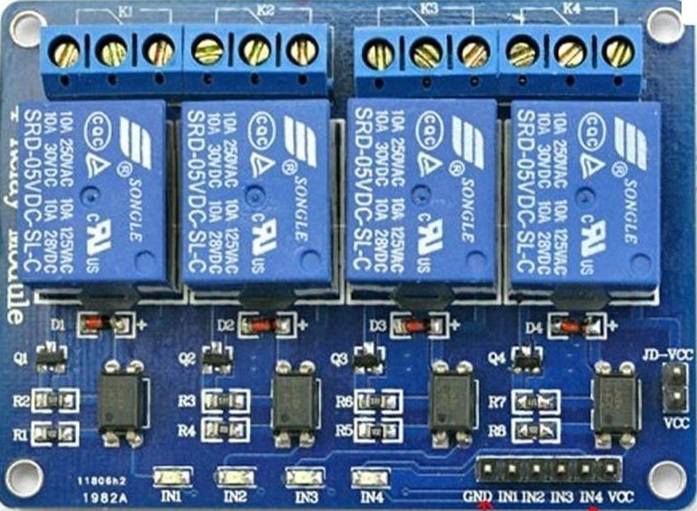
 Design with 4 channel relay module 5V JD-VCC in Cirkit Designer
Design with 4 channel relay module 5V JD-VCC in Cirkit DesignerIntroduction
The 4 Channel Relay Module 5V JD-VCC is a versatile electronic component designed to control up to four independent devices using a 5V power supply. Manufactured by Electronics Hub (Part ID: Mega 2560), this module is equipped with opto-isolation for enhanced safety and reliability. It is commonly used to switch high-voltage loads (AC or DC) with low-voltage control signals, making it ideal for home automation, industrial control systems, and IoT applications.
Explore Projects Built with 4 channel relay module 5V JD-VCC
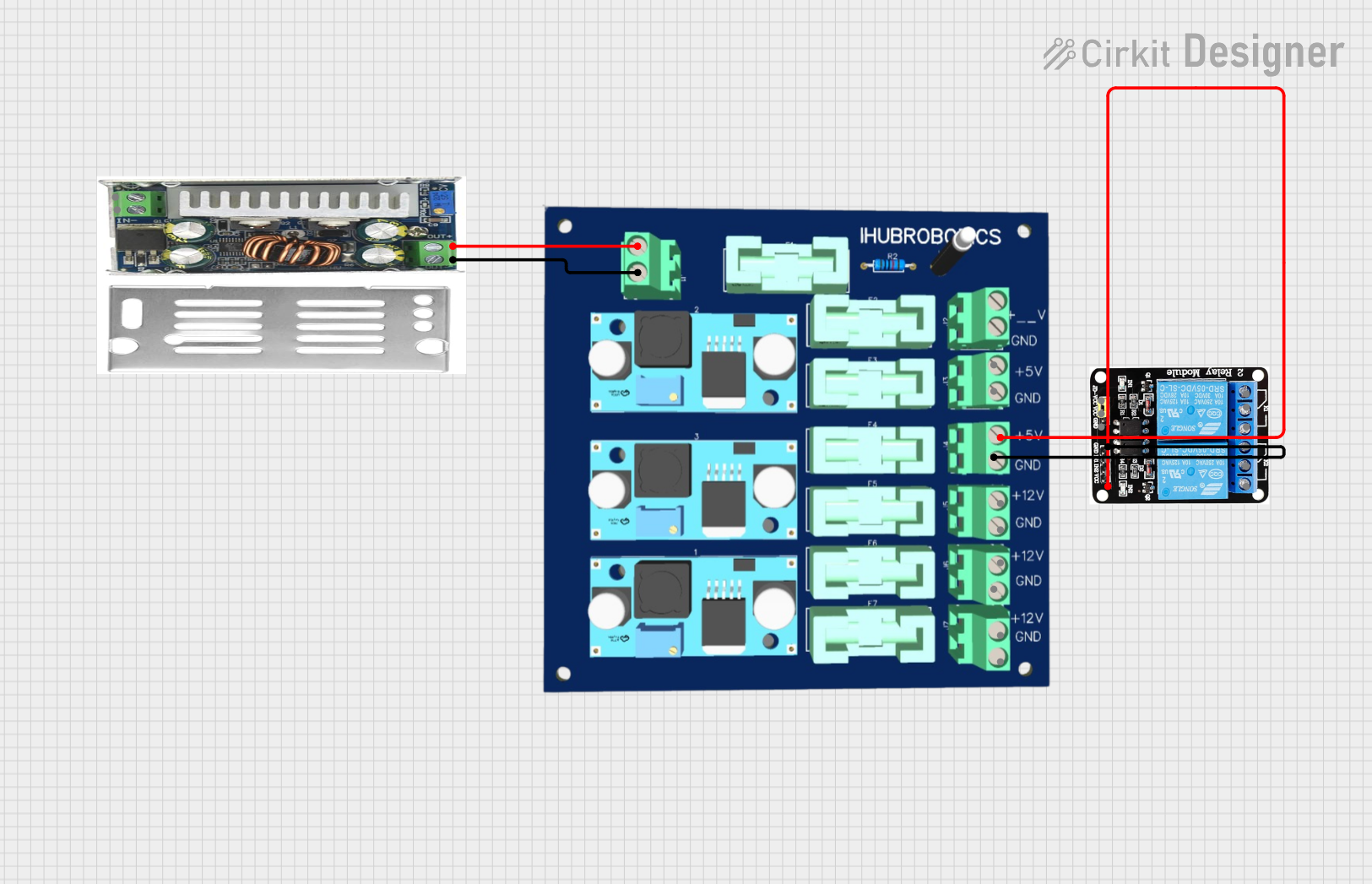
 Open Project in Cirkit Designer
Open Project in Cirkit Designer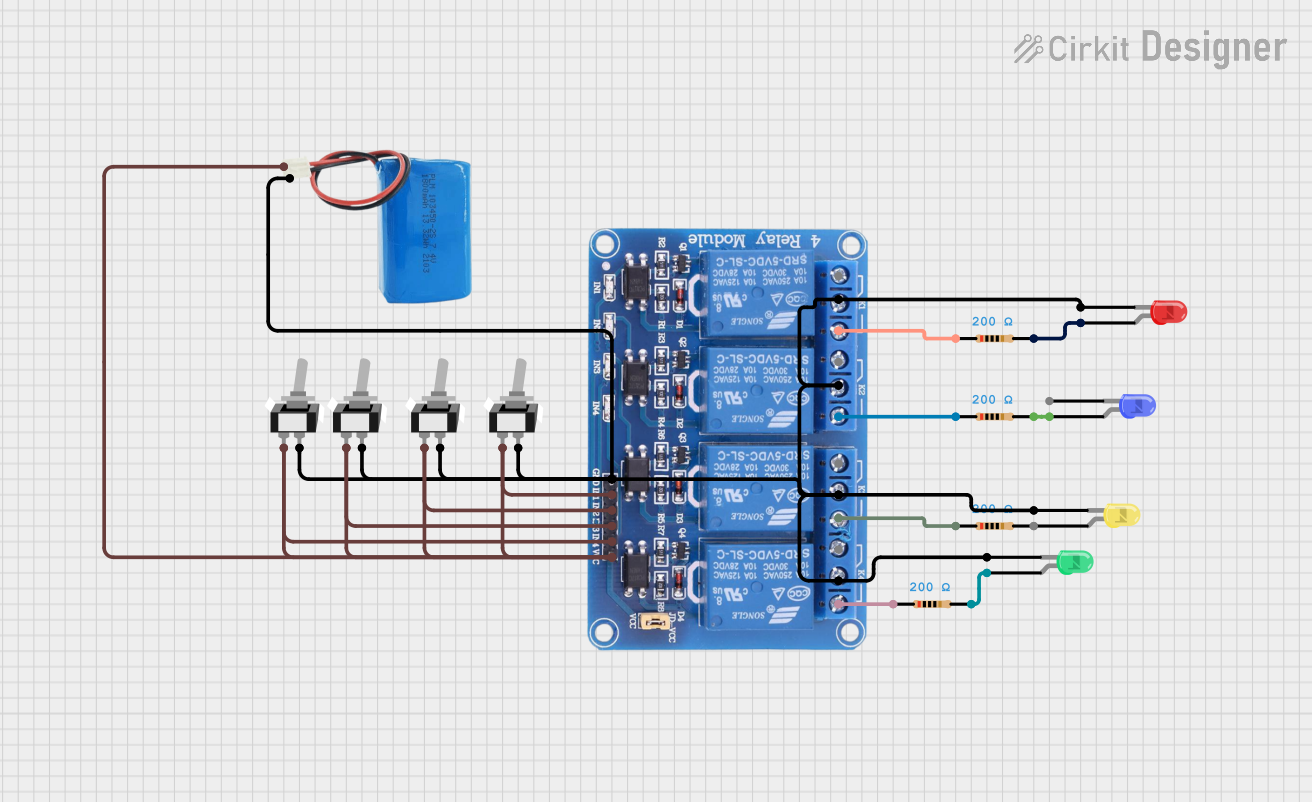
 Open Project in Cirkit Designer
Open Project in Cirkit Designer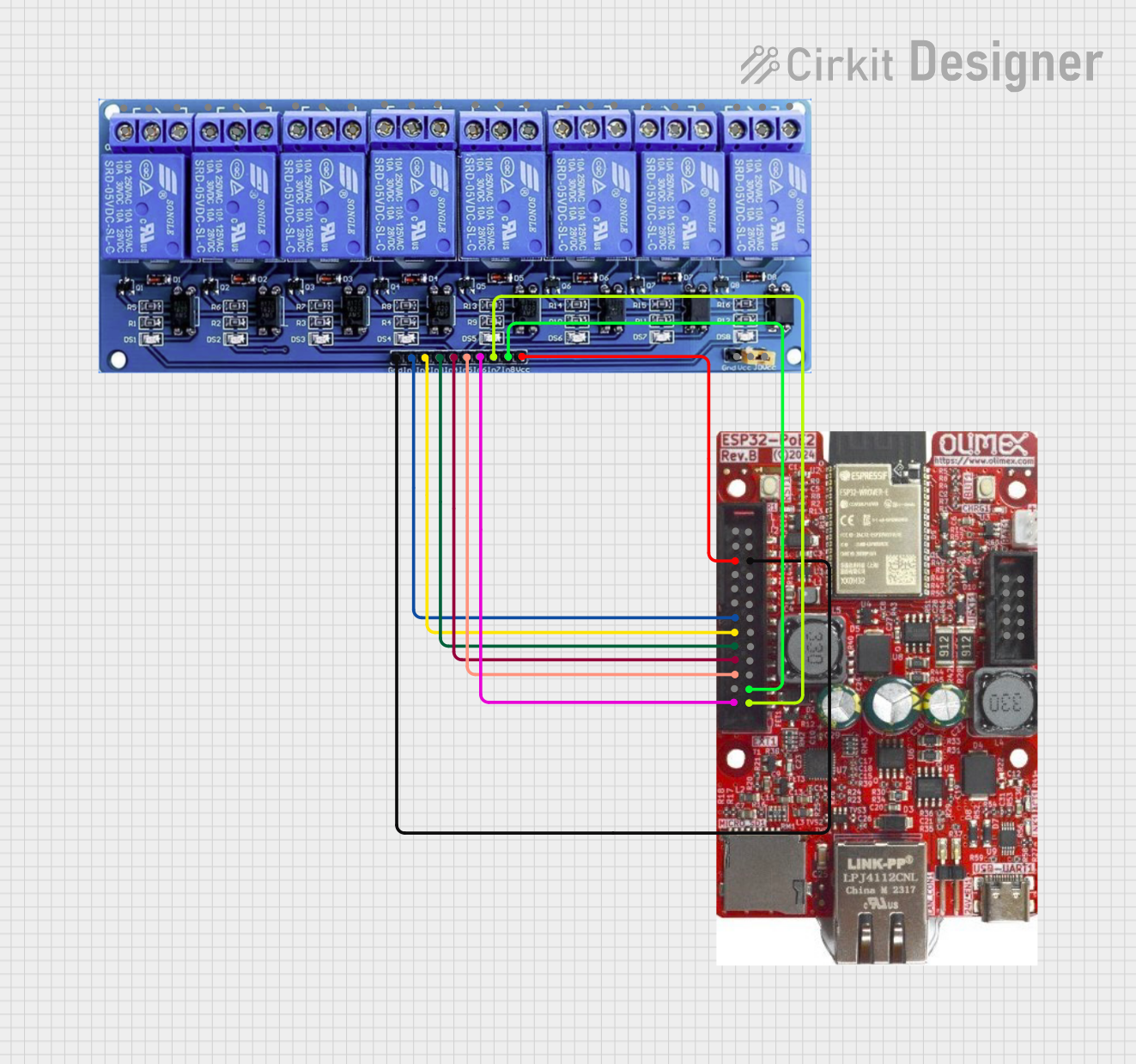
 Open Project in Cirkit Designer
Open Project in Cirkit Designer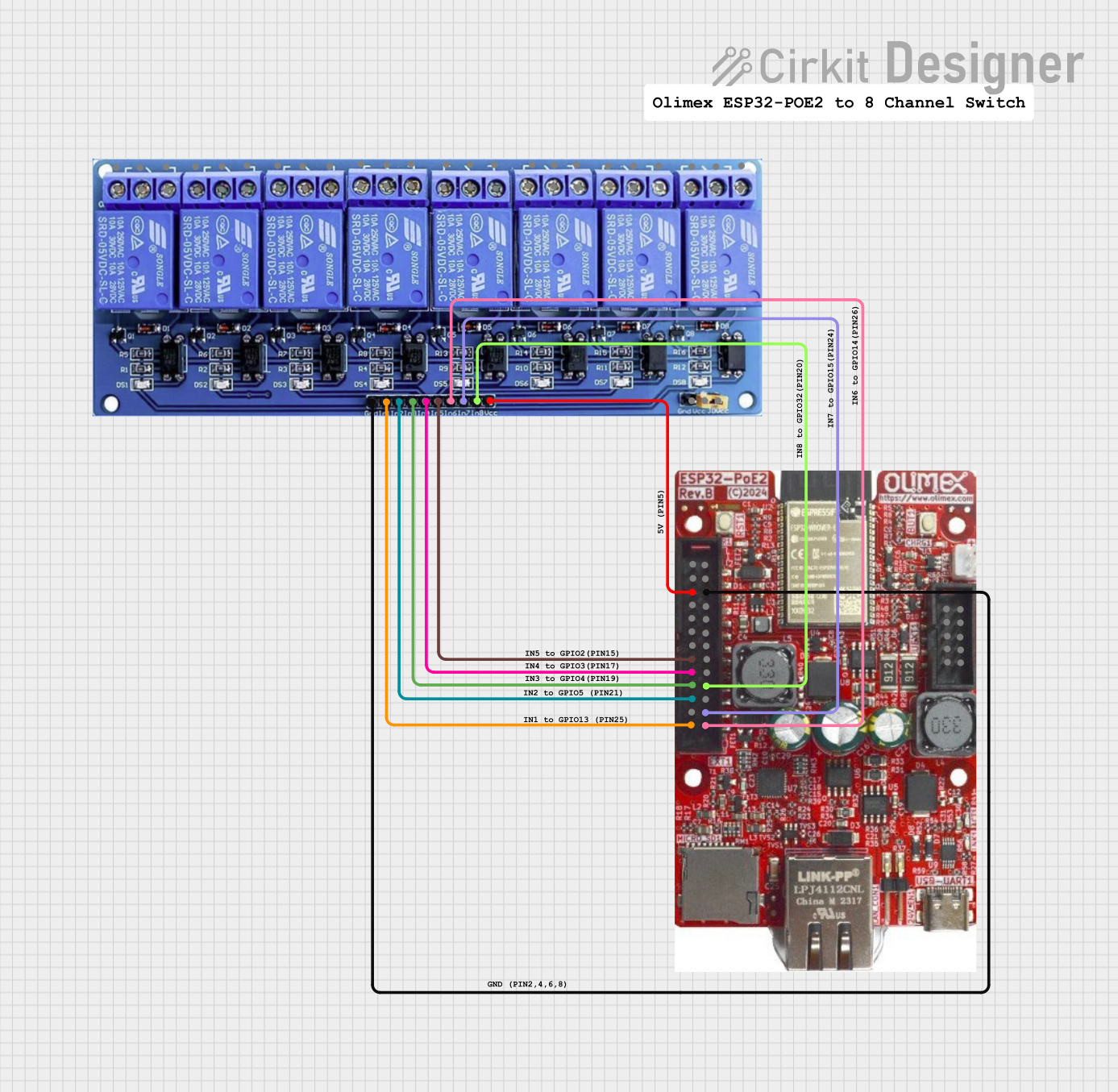
 Open Project in Cirkit Designer
Open Project in Cirkit DesignerExplore Projects Built with 4 channel relay module 5V JD-VCC

 Open Project in Cirkit Designer
Open Project in Cirkit Designer
 Open Project in Cirkit Designer
Open Project in Cirkit Designer
 Open Project in Cirkit Designer
Open Project in Cirkit Designer
 Open Project in Cirkit Designer
Open Project in Cirkit DesignerCommon Applications
- Home automation systems (e.g., controlling lights, fans, or appliances)
- Industrial equipment control
- IoT projects requiring high-voltage switching
- Robotics and motor control
- Smart energy management systems
Technical Specifications
The following table outlines the key technical details of the 4 Channel Relay Module:
| Parameter | Specification |
|---|---|
| Operating Voltage | 5V DC |
| Trigger Voltage | 3.3V to 5V DC |
| Relay Type | Electromechanical |
| Maximum Load (AC) | 250V AC @ 10A |
| Maximum Load (DC) | 30V DC @ 10A |
| Isolation Type | Opto-isolated |
| Number of Channels | 4 |
| Dimensions | 75mm x 55mm x 20mm |
| Weight | ~60g |
Pin Configuration and Descriptions
The module has two sets of pins: Input Pins for control signals and Relay Output Terminals for connecting external devices.
Input Pins
| Pin Name | Description |
|---|---|
| VCC | 5V power supply input for the relay module |
| GND | Ground connection |
| IN1 | Control signal for Relay 1 (Active LOW) |
| IN2 | Control signal for Relay 2 (Active LOW) |
| IN3 | Control signal for Relay 3 (Active LOW) |
| IN4 | Control signal for Relay 4 (Active LOW) |
| JD-VCC | Jumper pin for relay power isolation (optional) |
Relay Output Terminals
Each relay has three output terminals:
| Terminal | Description |
|---|---|
| NO (Normally Open) | Open circuit when the relay is inactive |
| NC (Normally Closed) | Closed circuit when the relay is inactive |
| COM (Common) | Common terminal for NO and NC connections |
Usage Instructions
How to Use the Module in a Circuit
- Power the Module: Connect the VCC pin to a 5V DC power supply and the GND pin to ground.
- Control Signals: Use digital output pins from a microcontroller (e.g., Arduino UNO) to send control signals to the IN1, IN2, IN3, and IN4 pins. A LOW signal activates the corresponding relay.
- Connect External Devices:
- For each relay, connect the device's power line to the COM terminal.
- Use the NO terminal if you want the device to be OFF by default and turn ON when the relay is activated.
- Use the NC terminal if you want the device to be ON by default and turn OFF when the relay is activated.
- Isolation (Optional): If you want to isolate the relay power supply from the control circuit, remove the JD-VCC jumper and provide a separate 5V power supply to the JD-VCC pin.
Important Considerations
- Opto-Isolation: Ensure the opto-isolation feature is used when working with high-voltage loads to protect the control circuit.
- Load Ratings: Do not exceed the maximum load ratings (250V AC @ 10A or 30V DC @ 10A) to avoid damage.
- Active LOW Logic: The relays are triggered by a LOW signal. Ensure your microcontroller outputs are configured accordingly.
- Separate Power Supply: For high-power applications, consider using a separate power supply for the relays to prevent voltage drops.
Example: Connecting to an Arduino UNO
Below is an example of how to control the 4 Channel Relay Module using an Arduino UNO:
Circuit Connections
- Connect the module's VCC pin to the Arduino's 5V pin and GND to GND.
- Connect IN1, IN2, IN3, and IN4 to Arduino digital pins 7, 6, 5, and 4, respectively.
- Connect an external device (e.g., a light bulb) to the COM and NO terminals of Relay 1.
Arduino Code
// Example code to control a 4 Channel Relay Module with Arduino UNO
// Define relay control pins
#define RELAY1 7 // Relay 1 connected to digital pin 7
#define RELAY2 6 // Relay 2 connected to digital pin 6
#define RELAY3 5 // Relay 3 connected to digital pin 5
#define RELAY4 4 // Relay 4 connected to digital pin 4
void setup() {
// Set relay pins as outputs
pinMode(RELAY1, OUTPUT);
pinMode(RELAY2, OUTPUT);
pinMode(RELAY3, OUTPUT);
pinMode(RELAY4, OUTPUT);
// Initialize all relays to OFF (HIGH state)
digitalWrite(RELAY1, HIGH);
digitalWrite(RELAY2, HIGH);
digitalWrite(RELAY3, HIGH);
digitalWrite(RELAY4, HIGH);
}
void loop() {
// Turn on Relay 1
digitalWrite(RELAY1, LOW); // Activate Relay 1
delay(1000); // Wait for 1 second
// Turn off Relay 1 and turn on Relay 2
digitalWrite(RELAY1, HIGH); // Deactivate Relay 1
digitalWrite(RELAY2, LOW); // Activate Relay 2
delay(1000); // Wait for 1 second
// Turn off Relay 2 and turn on Relay 3
digitalWrite(RELAY2, HIGH); // Deactivate Relay 2
digitalWrite(RELAY3, LOW); // Activate Relay 3
delay(1000); // Wait for 1 second
// Turn off Relay 3 and turn on Relay 4
digitalWrite(RELAY3, HIGH); // Deactivate Relay 3
digitalWrite(RELAY4, LOW); // Activate Relay 4
delay(1000); // Wait for 1 second
// Turn off all relays
digitalWrite(RELAY4, HIGH); // Deactivate Relay 4
delay(1000); // Wait for 1 second
}
Troubleshooting and FAQs
Common Issues
- Relays Not Activating:
- Ensure the module is powered with a stable 5V supply.
- Verify that the control signals are correctly connected and configured as LOW to activate the relays.
- Voltage Drops:
- Use a separate power supply for the relays if the microcontroller cannot provide sufficient current.
- Device Not Switching:
- Check the wiring of the COM, NO, and NC terminals.
- Ensure the load does not exceed the relay's maximum ratings.
FAQs
Q: Can I use this module with a 3.3V microcontroller?
A: Yes, the module supports trigger voltages as low as 3.3V. However, ensure the VCC pin is still powered with 5V.
Q: What is the purpose of the JD-VCC jumper?
A: The JD-VCC jumper allows you to isolate the relay power supply from the control circuit. Remove the jumper and provide a separate 5V supply to JD-VCC for isolation.
Q: Can I control AC devices with this module?
A: Yes, the module can switch AC devices up to 250V at 10A. Ensure proper safety precautions when working with high voltages.